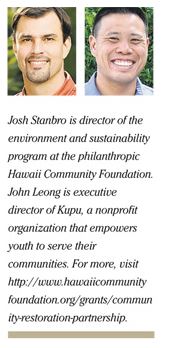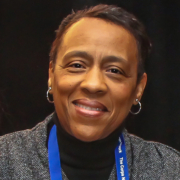
John Leong, Executive Director of Kupu, operators of the Hawaii Youth Conservation Corps, recently co-authored an editiorial published by the Star Advertiser. It is republished below.
 Island Voices: Efforts to restore Hawaii’s ecosystem serve many socially beneficial goals
Island Voices: Efforts to restore Hawaii’s ecosystem serve many socially beneficial goals
By Josh Stanbro and John Leong
POSTED: 01:30 a.m. HST, May 11, 2014
Our freshwater streams and ocean have long been at the center of Hawaii’s culture and ecosystem.
Today, the impacts of climate change and changing land uses are threatening the balance of our environment, reducing our rainfall, eroding our beaches and harming our ocean resources.
To address these challenges, the Hawaii Community Foundation recently announced its 2014 grant recipients from the Community Restoration Partnership grant program.
 The partnership brings together forward-thinking donors and dynamic nonprofit programs to find solutions for the critical challenge of our time: How do we make Hawaii as secure as possible in the face of diminishing fish stocks, invading species and increasing drought?
The partnership brings together forward-thinking donors and dynamic nonprofit programs to find solutions for the critical challenge of our time: How do we make Hawaii as secure as possible in the face of diminishing fish stocks, invading species and increasing drought?
Since 2009, the partnership has worked collaboratively to protect Hawaii’s nearshore ecosystems and encourage a robust, healthy fish population that will sustain future generations.
The partnership has come to understand that it can’t fix Hawaii’s reefs and stabilize its marine environment without following the problem upstream, addressing the source. In order to achieve a sustainable future, we must restore our coastal lands and waters from mauka to makai.
As one of nine partnership grantees for 2014, Kupu’s Community U program is one bright example of Hawaii’s people coming together to protect our island home. Community U puts underserved youth to work on the ground at conservation and cultural sites throughout the state, providing assistance and aid to grassroots restoration efforts.
On Oahu’s windward side at Heeia, for example, invasive plants with shallow root systems have crowded out native growth along natural streams and traditional taro lo’i, allowing soil to be stripped from the land and eventually swept into the sea. Hawaii’s fish populations and coastal waters have become threatened by tons of sediment gradually smothering the once-healthy coral reef systems. Here, Kupu is hard at work with Papahana Kuaola and Kako’o ʻŌiwi to remove invasive species, replant native vegetation and restore traditional taro lo’i that trap sediment and clean stormwater runoff.
Beyond this important work to repair terrestrial and marine resources, Kupu’s Community U program provides opportunities for at-risk youth coming from difficult situations (in some cases, incarceration) to turn their lives around — a second chance to obtain a diploma, gain transferable job skills, develop life skills and successfully build career pathways.
Hawaii’s environment has been impaired because of human impact, certainly, but our greatest threat is apathy. Community U tackles these challenges head-on both by reversing damage to the land now, and restoring our youth as responsible change agents who care and are dedicated to stewarding themselves and our islands over the long term.
Our quality of life and the resilience of our aina and oceans in the 21st century are directly dependent on the people of Hawaii healing the land, and the land in turn helping to heal us.
Thanks to forward-thinking grant funders — including the Hawaii Community Foundation, the National Oceanic and Atmospheric Administration, the Weissman Family Foundation, the Hawaii Tourism Authority and the Harold K.L. Castle Foundation — the partnership is able to directly support restoration projects for a cleaner, healthier Hawaii.
Work is underway to clear the waters at Heeia, but Hawaii needs community restoration projects in every single ahupua’a around our Islands.
Restored lands defend against the scourge of invasive species, capture precious raindrops and absorb them into our aquifers, and hold the line against sediment and erosion that reduce our marine and fish populations.
The Community Restoration Partnership firmly believes in supporting community groups that organize in their backyard to restore their own beloved places. We encourage other funders and donors to join the partnership and expand our impact.


































































